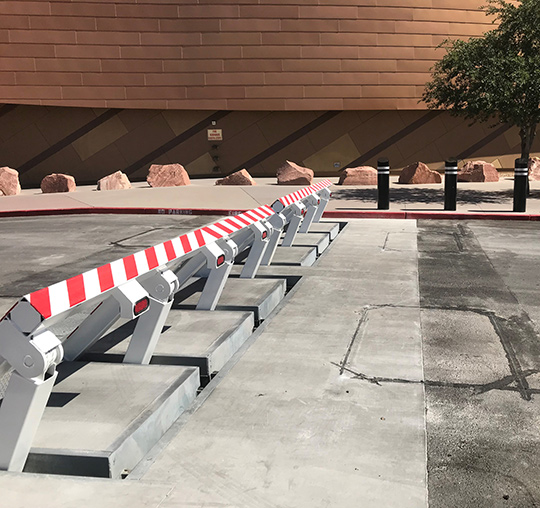Indicators on Wedge Barriers You Need To Know
Table of ContentsLittle Known Facts About Wedge Barriers.8 Easy Facts About Wedge Barriers Explained

The 10-Minute Rule for Wedge Barriers
The remaining force applied to
the cam to deploy release wedge plate 16 may be provided given an electromechanical actuator 84 or other various other. The springtime setting up 54 and the actuator 84(e. Wedge Barriers. g., electromechanical actuator)may run together to convert the webcam and raise the wedge plate 16.
As discussed over, the spring setting up 54 exerts a consistent force on the web cam, while the electromechanical actuator may be managed to apply a variable force on the cam, thus allowing the training and lowering( i. e., deploying and retracting )of the wedge plate 16. In certain embodiments, the consistent force applied by the springtime setting up 54 might be flexible. g., electromechanical actuator) is handicapped. As will be appreciated, the spring setting up 54 might be covered and shielded from particles or other elements by a cover plate(e. g., cover plate 68 displayed in FIG. 4) that may be significantly flush with the elevated surface 38 of the foundation 14. As discussed over, in the deployed position, the wedge plate 16 offers to obstruct gain access to or travel past the barrier 10. For instance, the obstacle 10(e. g., the wedge plate 16 )might obstruct pedestrians or lorries from accessing a home or path. As reviewed over, the obstacle 10 is connected to the anchor 30 secured within the foundation 14,
front brackets 71. Because of this, the affiliation assemblies 72 may pivot and rotate to make it possible for the collapse and extension of the linkage assemblies 72 during retraction and deployment of the bather 10. The link his explanation settings up 72 reason movement of the wedge plate 16 to be restricted. For instance, if an automobile is taking a trip in the direction of the released wedge plate 16(e. For instance, in one scenario, the security legs 86 might be prolonged duringmaintenance of the obstacle 10. When the safety and security legs 86 are deployed, the safety legs 86 support the weight of the wedge plate 16 versus the surface area 12. As a result, the training system 50 might be deactivated, serviced, eliminated, changed, etc. FIG. 5 is partial perspective sight of a personification of the surface-mounted wedge-style obstacle 10, illustrating the cam 80 and the web cam surface areas 82 of the lifting mechanism 50. Particularly, 2 webcam surface areas 82, which are described as lower web cam surface areas 83, are placed listed below the camera 80. The reduced camera surfaces 83 might be dealt with to the surface area 12 (e. For instance, the lower web cam surface areas 83 and the installing plate 85 might create a knockout post a solitary piece that is secured to the anchor 30 by screws or other mechanical bolts. In addition, 2 cam surface areas 82, which are referred to as top camera surfaces 87, are positioned above the cam 80 and coupled to (e. In various other personifications, stepping in layers or plates may be positioned in between the surface 12 and the lower web cam surface areas 83 and/or the wedge plate 16 and the upper cam surface areas 87 As pointed out over, the web cam
80 converts along the web cam surface areas 82 when the wedge plate 16 is raised from the retracted position to the released setting. Furthermore, as discussed above, the springtime setting up 54 (see FIG. 3 )may provide a pressure acting on the web cam 80 in the direction 102 by means of spring rod 58, which may lower the pressure the electromechanical actuator 84 is called for to dig this relate to the camera 80 in order to actuate and raise the wedge plate 16. 1 )to the deployed position(see FIG. 4). As revealed, the camera 80 consists of track wheels 104(e. g., rollers), which call and convert along the cam surfaces 82 during procedure.